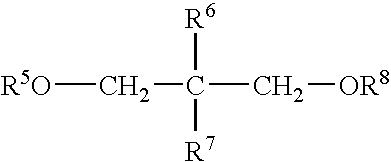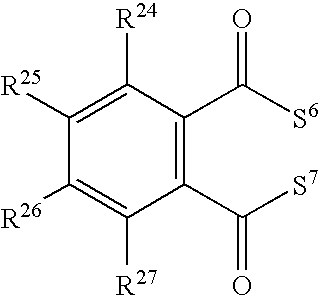Solid catalyst component for alpha-olefin polymerization, process for producing catalyst therefor, and process for producing alpha-olefin polymer
- Summary
- Abstract
- Description
- Claims
- Application Information
AI Technical Summary
Benefits of technology
Problems solved by technology
Method used
Image
Examples
example 1
(1) Production of the Component (a)
[0120] A reactor equipped with a stirrer was purged with nitrogen, and thereinto, 800 liters of hexane, 6.8 kg of diisobutyl phthalate, 350 kg of tetraethoxysilane and 38.8 kg of tetrabutoxytitanium were put, and a resultant mixture was stirred. To the mixture maintained at 7° C. (temperature of a reactor), 900 liters of a dibutyl ether solution (concentration: 2.1 mol / liter) of butylmagnesium chloride was added dropwise over 5 hours. The obtained mixture was stirred at 20° C. for one hour, and a reaction mixture was filtered to separate a solid. The separated solid was washed three times with each 1,100 liters of toluene. To the washed solid, toluene was added to obtain 625 liters of a slurry thereof. The slurry was stirred at 70° C. for 1 hour, and then, was cooled to a room temperature.
[0121] A part of the slurry was sampled, and was filtered to separate a solid, which was washed with hexane at a room temperature, and was dried under a reduce...
example 2
(1) Production of the Component (A)
[0152] Example 1 (2) was repeated except that the amount of 2-isopropyl-2-isobutyl-1,3-dimethoxypropane used was changed to 1.5 ml.
[0153] An elemental analysis of the obtained component (A) showed a content of a titanium atom of 1.93% by weight, that of phthalic acid ester compounds of 9.6% by weight, and that of 2-isopropyl-2-isobutyl-1,3-dimethoxypropane of 7.2% by weight. A molar ratio of the content of 2-isopropyl-2-isobutyl-1,3-dimethoxypropane to that of the phthalic acid ester compounds was 0.87.
(2) Polymerization of Propylene
[0154] Example 1 (3) was repeated except that 5.41 mg of the component (A) was changed to 6.76 mg of the component (A) produced in the above Example 2 (1), thereby obtaining 327 g of a polypropylene powder.
[0155] PP / cat was 48,400 g / g, and the obtained polypropylene had CXS of 0.48% by weight, [η] of 0.74 dl / g, and a bulk density of 0.417 g / ml.
[0156] Results are summarized in Table 1.
example 3
(1) Polymerization of Propylene
[0157] A 3-liter stainless steel autoclave was purged with argon. Thereinto, 2.6 mmol of triethylaluminum (component (B)), 0.26 mmol of cyclohexylethyldimethoxysilane (component (C)), and 7.68 mg of the component (A) produced in Example 1 (2) were put, and then, hydrogen corresponding to a partial pressure of 0.033 MPa was added thereto.
[0158] Into the autoclave, 780 g of a liquefied propylene was fed, and then, it was polymerized at 80° C. for one hour, and thereafter, the unpolymerized propylene was purged. The resultant polymer was dried under a reduced pressure to obtain 356 g of a polypropylene powder.
[0159] PP / cat was 46,400 g / g, and the obtained polypropylene had CXS of 0.39% by weight, [η] of 1.95 dl / g, and a bulk density of 0.427 g / ml.
[0160] Results are summarized in Table 1.
PUM
| Property | Measurement | Unit |
|---|---|---|
| Percent by mass | aaaaa | aaaaa |
| Percent by mass | aaaaa | aaaaa |
| Substance count | aaaaa | aaaaa |
Abstract
Description
Claims
Application Information
 Login to View More
Login to View More - R&D
- Intellectual Property
- Life Sciences
- Materials
- Tech Scout
- Unparalleled Data Quality
- Higher Quality Content
- 60% Fewer Hallucinations
Browse by: Latest US Patents, China's latest patents, Technical Efficacy Thesaurus, Application Domain, Technology Topic, Popular Technical Reports.
© 2025 PatSnap. All rights reserved.Legal|Privacy policy|Modern Slavery Act Transparency Statement|Sitemap|About US| Contact US: help@patsnap.com



